AI in Government: Examples, Challenges & Best Practices [2024]
![AI in Government: Examples, Challenges & Best Practices [2024]](https://research.aimultiple.com/wp-content/uploads/2020/12/Deloitte-AI-in-government-382x292.png.webp)
![AI in Government: Examples, Challenges & Best Practices [2024]](https://research.aimultiple.com/wp-content/uploads/2020/12/Deloitte-AI-in-government-824x630.png.webp)
Artificial intelligence adoption is increasing. 90% of top businesses have an ongoing AI investment. And customers who are delighted with the personalized experiences they get from brands, thanks to AI, start to expect the same experience from every organization they engage with.
According to Gartner, governments need to focus on scaling digital initiatives because more than 85% of governments without a total experience strategy by 2023 will fail to transform services. As a result, governments are following in the footsteps of businesses and are willing to invest in AI. For example, recently, Danish architecture firm BIG and Chinese tech company Terminus revealed their plans to build an “AI City” project named Cloud Valley in the south-western Chinese city of Chongqing.
In this article, we focus on AI applications in government to inform public authorities. In this regard, we will answer all important questions regarding artificial intelligence deployment in public institutions, from challenges and best practices to real-world public sector case studies.
What does artificial intelligence offer to governments?
What AI offers to governments is similar to what AI offers to the private sector. These offerings can be classified into three categories:
- Savings due to operational efficiency: According to Governing magazine, 53% of state and local officials surveyed had excessive paperwork burdens that impacted their ability to get work done. According to Deloitte, automation of federal government employee tasks could save between 96.7 million and 1.2 billion hours annually. The same Deloitte study also reports that automation and AI have the potential to save between $3.3 billion and $41.1 billion. For automation opportunities, check our articles on RPA and intelligent automation in government.
- New/improved services: Citizen-facing applications like self-driving shuttles and personalized education improve the quality of services governments deliver to citizens.
- More data-driven decision making: Governments are collecting an abundant amount of data every day. Yet, without an accurate analysis, data is not adequate for actionable insights. Better decision making has the potential to both improve services and save costs.
What is the level of government’s interest in AI?
61% of government decision-makers state that AI is at least moderately functional in their organizations, according to a 2021 survey by KPMG. Moreover, 79% of them believe AI will improve bureaucratic efficiency.
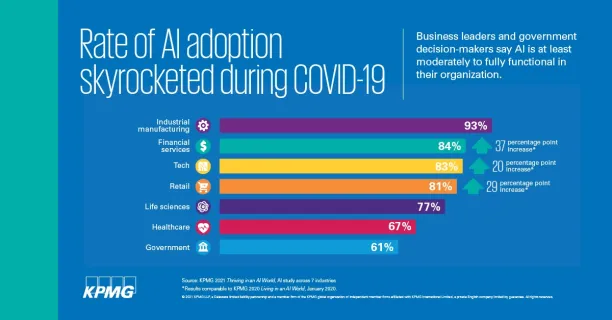
What are AI applications/ use cases in government?
Government services
Social Welfare
- Identifying fraudulent benefits claims: Fraudulent claims cost governments billions. For instance, it is expected that £1.5bn may have been lost in fraudulent claims for Universal Credit in the UK after the coronavirus pandemic. AI-powered fraud detection can enable governments to track down large-scale corruption of the benefit and welfare programs by
- identifying patterns in claims such as the same phone number or applications written in the same style
- processing social media profiles to check if there are any conflicting information compared to the applications. However, this may be perceived as an infringement of personal data in many countries.
Healthcare
- Tracking disease spreads: AI can be used to prevent disease spread. To do this, there are two types of AI applications, which are:
- Building a machine learning algorithm that cross-checks patients with similar symptoms from different locations, detects patterns, and warns when an outbreak might occur.
- Using graph analytics, as in the case of China during COVID-19, to identify contacts with a known carrier of the virus
- Triaging patients: Though triaging patients has been used in hospitals’ emergency services, triaging became necessary after coronavirus spread. AI-powered tools can analyze patient data to predict patients’ risk scores so that doctors can prioritize.
- Handling citizens health related queries: Public health was endangered by misinformation about pandemic measures, particularly at the beginning of the COVID-19 pandemic, as well as ambiguity about what citizens might do to protect or quarantine themselves. Conversational AI technologies can assist governments in informing their people and assisting authorities in responding to frequently requested queries about health.
Domestic security
- Predicting a crime and recommending optimal police presence: AI can be used to identify patterns in policing heat maps to forecast where and when next crimes are likely to occur as in the graph below. Though AI algorithms’ fairness in predictive policing is still questionable and it doesn’t favor minority groups, AI-based recommendations can be used to identify optimal police patrol presence. Solutions like Palantir enable it to conduct geo-searches around locations of interest and view relevant arrest data for law enforcement.
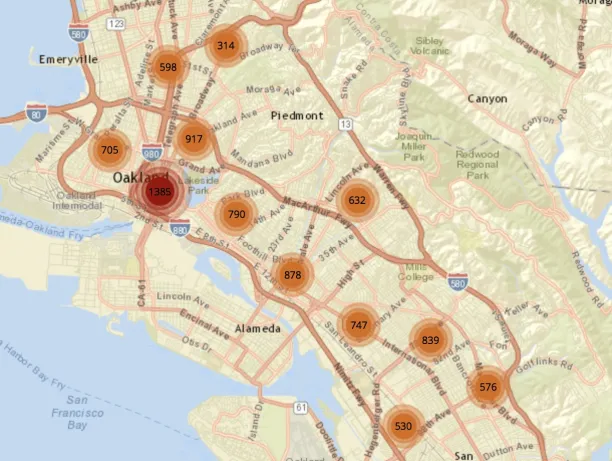
- Surveillance: AI surveillance describes the process of ML and DL-based algorithms analyzing images, videos, and data recorded from CCTV cameras. Though techniques like facial recognition enable governments to identify people from video records, the ethical side of AI-powered surveillance is still controversial. For instance, IBM stopped offering, developing, or researching facial recognition technology for mass surveillance due to racial profiling and violations of basic human rights and freedoms.
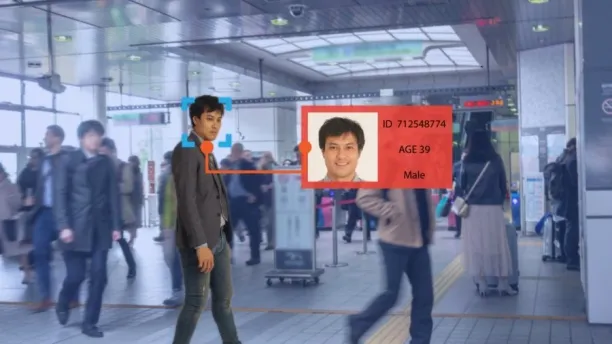
Military
- Autonomous drones: Autonomous military drones are also referred to as Unmanned combat aerial vehicles (UCAV), are military weapons that carry combat payloads like missiles are usually under real-time human control, with varying levels of autonomy. One of the latest examples of military drones, though they were mostly piloted by humans, were used by Azerbaijan at Nagorno-Karabakh in the combat against Armenia.
Transportation
- Self-driving shuttles: Autonomous shuttles are a flexible solution to move people at sub-50km/h speeds along predetermined, learned paths like industrial campuses, city centers, or suburban neighborhoods. Self-driving shuttle trial deployments are expected to accelerate quickly because
- The shuttle segment is less regulated than the automotive market.
- Consumers’ trust in autonomous shuttles is higher than other autonomous vehicles. According to a survey conducted by the University of Michigan, 86% of riders said they trusted shuttles after riding in it, as did 66% of nonriders. On the contrary, another survey highlights that 70% of Americans would not trust an autonomous vehicle.
- Monitoring social media to identify incidents: Traffic congestions are an issue for citizens and governments alike. Congestions happen mostly due to accidents on roads, and it negatively impacts travel times, fuel consumption, and carbon emissions. Artificial intelligence can be used to monitor social media to identify tweets about recent accidents. Here is a research paper from the University of Wolverhampton on incident detection using NLP techniques.


Education
- Personalized education: ML algorithms can help provide personalized education irrespective of the number of students. AI can analyze students’ progress and find the gaps between what is taught and what is not yet understood.
- Marking exam papers: At the University of Michigan, students receive immediate feedback on their writing, even in large classes, thanks to AI. Automated text analysis reviews students’ work to identify strengths and recommend revisions.
Emergency
- Classifying emergency calls based on their urgency: Voice recognition technologies & ML algorithms can help governments automate emergency call lines by understanding and categorizing queries.
- Fire prediction: ML & DL algorithms map the dryness of forests to predict wildfire better.
Public relations
- Customer service chatbots: Chatbots are the most common use case of AI in government. Chatbots enable governments to perform a variety of tasks, including:
- Scheduling meetings
- Answering FAQs
- Directing requests to the appropriate area within government
- Filling out forms
- Assisting with searching documents
- Helping out recruitment (e.g., United States Army )
- Checking on social media posts for citizen feedback purposes: Every minute, Twitter users tweet 347,222 times. By processing a vast amount of data with AI, the public sector can gain feedback from citizens to improve their services.
Others
- Document automation includes extraction and inputting of invoices, architectural drawings, certificates, charts, drawings, forms, legal documents, and letters.
- Drafting documents & announcements: Automated content can be generated with Natural Language Generation (NLG), which is already being used in some newsrooms.
- Translation: AI enables a more efficient translation of government information. For example, the PyeongChang Winter Olympics in Korea will be using AI-based real-time translation services.
What are the challenges of AI in the public sector?
Employment
Unemployment is the scariest part of artificial intelligence if we disregard the hypothetical scenario of an AI takeover. Governments, as public service providers, should be concerned about the impact of AI on human jobs in government. To mitigate the impact of potential unemployment due to automation, governments need to ensure that humans focus on higher value-added tasks or move on to the private sector if their current tasks are going to be automated.
According to the European Commission’s Eurobarometer survey that presents European citizens’ thoughts on the influence of digitalization and automation on daily life
- 74% of respondents expect that more jobs will disappear than new jobs will be created due to the use of robots and artificial intelligence.
- 72% of respondents believe robots steal peoples’ jobs.
- 44% of respondents who are currently working think their current job could at least partly be done by a robot or artificial intelligence.
AI biases
AI algorithms may contain biases due to prejudices of the algorithm development team or misleading data. Though building an unbiased AI algorithm is technically possible, AI can be as good as data, and people are the ones who create data. Therefore the best thing governments can do for AI bias is minimizing it by applying best practices.
Explainability
It is not easy to explain how all AI algorithms arrive at their predictions (i.e., inferences) however there are technical approaches being developed to overcome this shortcoming.
This is problematic for the public sector, where providing a rationale for decisions is more important than the private sector since the public sector is accountable to the public. In contrast, the private sector is foremost accountable to shareholders.
Accountability
Accountability of AI systems is an issue of AI ethics. Governments are like the US and the UK are introducing new laws about companies’ AI algorithms’ accountability. It will be hypocrisy if governments and companies are not held accountable for accidents & false predictions their AI algorithms make.
Check our article on responsible AI to learn more.
Difficulty of transformation
AI transformation in government is difficult because
- Age of public servants: The workforce at the government is older than the private sector, making it potentially harder to implement to the culture change. According to U.S. Census Bureau research, about 24% of public-sector workers are millennials, compared with 34% in the private sector.
- More ambiguous/complex KPIs: Compared to the private sector’s drive for profit, governments have more complex, harder-to-measure goals. As a result, government KPIs tend to be more activity-oriented rather than result-oriented making it harder to measure improvements.
- Number of stakeholders: Government watchdogs, labor unions, and opposition parties are all stakeholders whose view of AI will shape how the public will perceive AI in government. This makes communication about transformation projects even more important.
What are the best practices of AI for governments?
Some best practices of AI transformation are:
- Involve people more: Investments alone are not enough for AI projects. Human and processes aspects also help achieve success from AI projects.
- Enhance technology infrastructure: AI deployment may require the restructuring of the technology infrastructure for faster system integration.
- Improve data quality & collection: AI is data hungry. Collecting high quality data is a prerequisite for numerous AI implementations.
- Involve the experts: Recruit professionals who are proficient in ML and AI deployments. AI consulting and custom AI development firms can provide the necessary experience and talent for governments.
- Reduce bias in AI: Follow best practices to reduce AI bias can also guide governments during their AI projects
Feel free to check our related article for more information.
Case studies
| Country | Instituite | Application | Results |
|---|---|---|---|
| Australia | Taxation Office | Chatbot/Virtual assistant | -Had more than 3 million conversations -Resolved 88% of queries
on first contact.
|
| Australia | Department of Human Services | Chatbot/Virtual assistant | can answer general questions about family, job seeker and student
payments and related information.
|
| Canada | Surrey Municipial | Chatbot/Virtual assistant | helps the residents of the city get answers to questions
related to municipal infrastructure
|
| United States | Atlanta Fire Rescue Department (AFRD) | Predictive Analytics | accurately predicted 73% of fire incidents in the building. |
| United States | Department of Energy | Solar Forecasting | machine learning based forecasts are as much as 30% more
accurate than ones created using conventional approaches.
|
| United States | New York City Department of Social Services (DSS) | Machine Vision | Digitization of documents is achieved |
| United States | City of Pittsburgh | Automated traffic optimization | Scalable Urban Traffic Control (SURTrAC) is connected to a network
of nine traffic signals in three significant roads in Pittsburgh (Penn Circle, Penn Avenue, and Highland Avenue)
|
To learn more
Leave us a comment if you know of other applications of AI in government. Here is a list of more AI-related articles you might be interested in:
You can also check out our list of AI tools and services:
And if you still have questions about AI applications in government, don’t hesitate to contact us:

Cem has been the principal analyst at AIMultiple since 2017. AIMultiple informs hundreds of thousands of businesses (as per similarWeb) including 60% of Fortune 500 every month.
Cem's work has been cited by leading global publications including Business Insider, Forbes, Washington Post, global firms like Deloitte, HPE, NGOs like World Economic Forum and supranational organizations like European Commission. You can see more reputable companies and media that referenced AIMultiple.
Throughout his career, Cem served as a tech consultant, tech buyer and tech entrepreneur. He advised businesses on their enterprise software, automation, cloud, AI / ML and other technology related decisions at McKinsey & Company and Altman Solon for more than a decade. He also published a McKinsey report on digitalization.
He led technology strategy and procurement of a telco while reporting to the CEO. He has also led commercial growth of deep tech company Hypatos that reached a 7 digit annual recurring revenue and a 9 digit valuation from 0 within 2 years. Cem's work in Hypatos was covered by leading technology publications like TechCrunch and Business Insider.
Cem regularly speaks at international technology conferences. He graduated from Bogazici University as a computer engineer and holds an MBA from Columbia Business School.
To stay up-to-date on B2B tech & accelerate your enterprise:
Follow on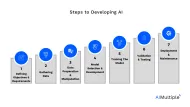
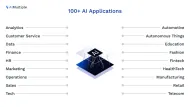
Comments
Your email address will not be published. All fields are required.